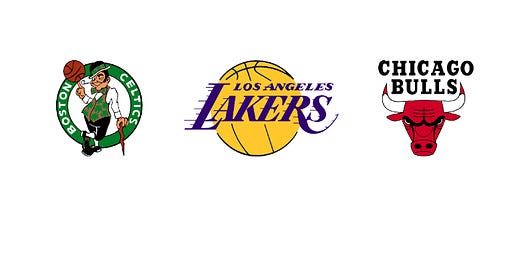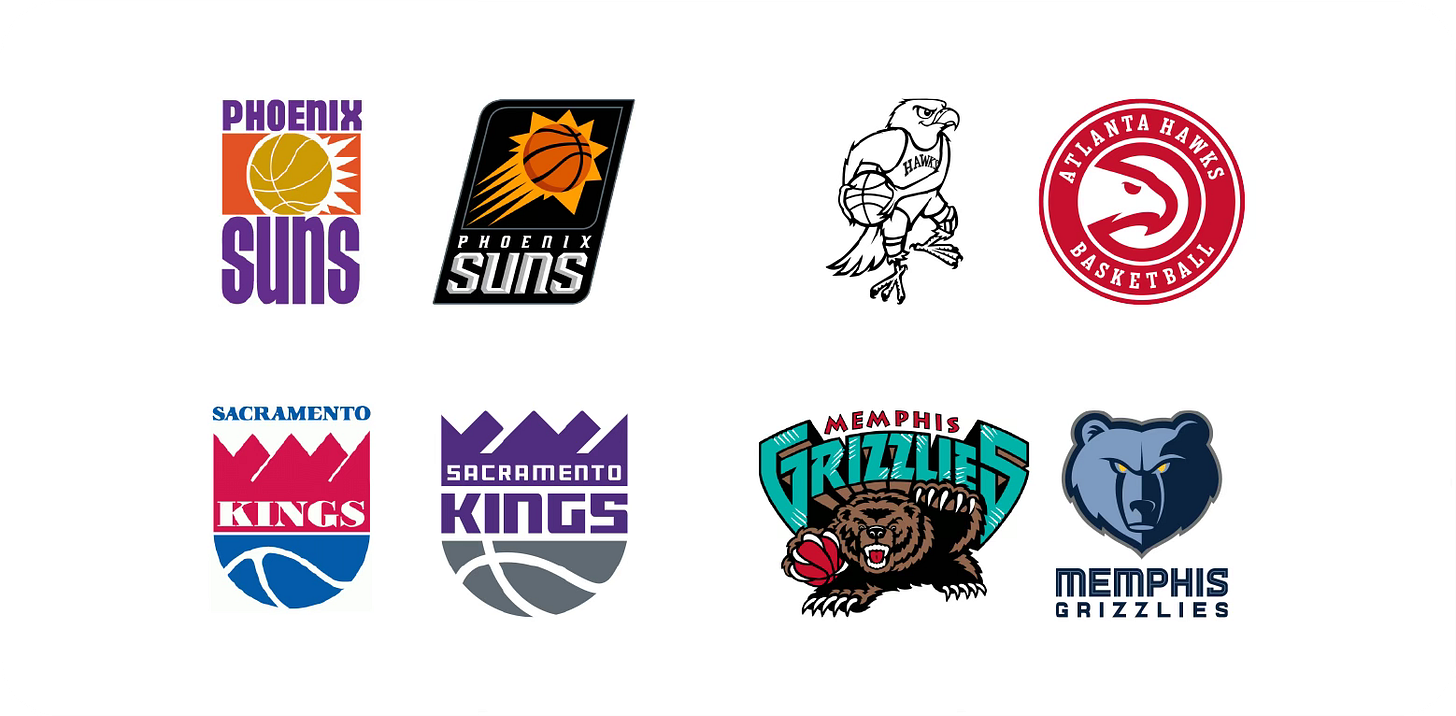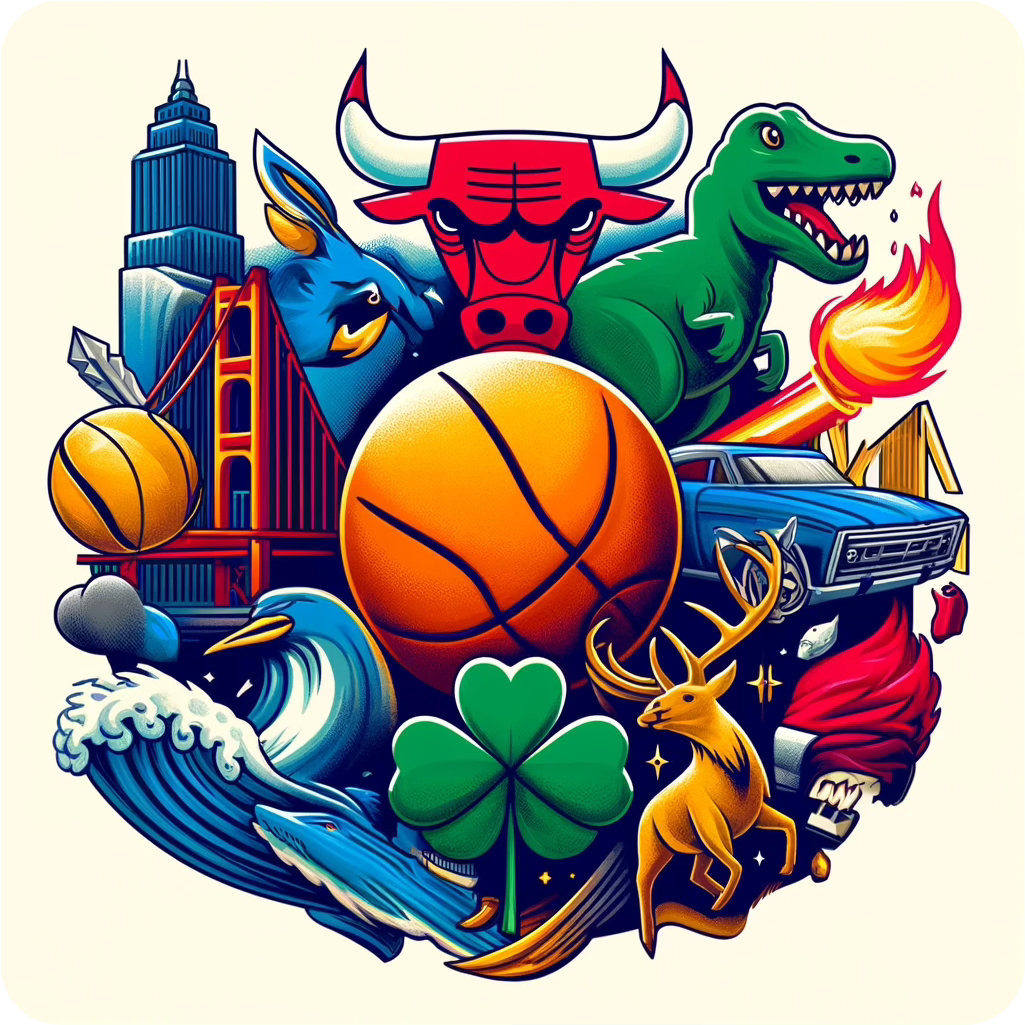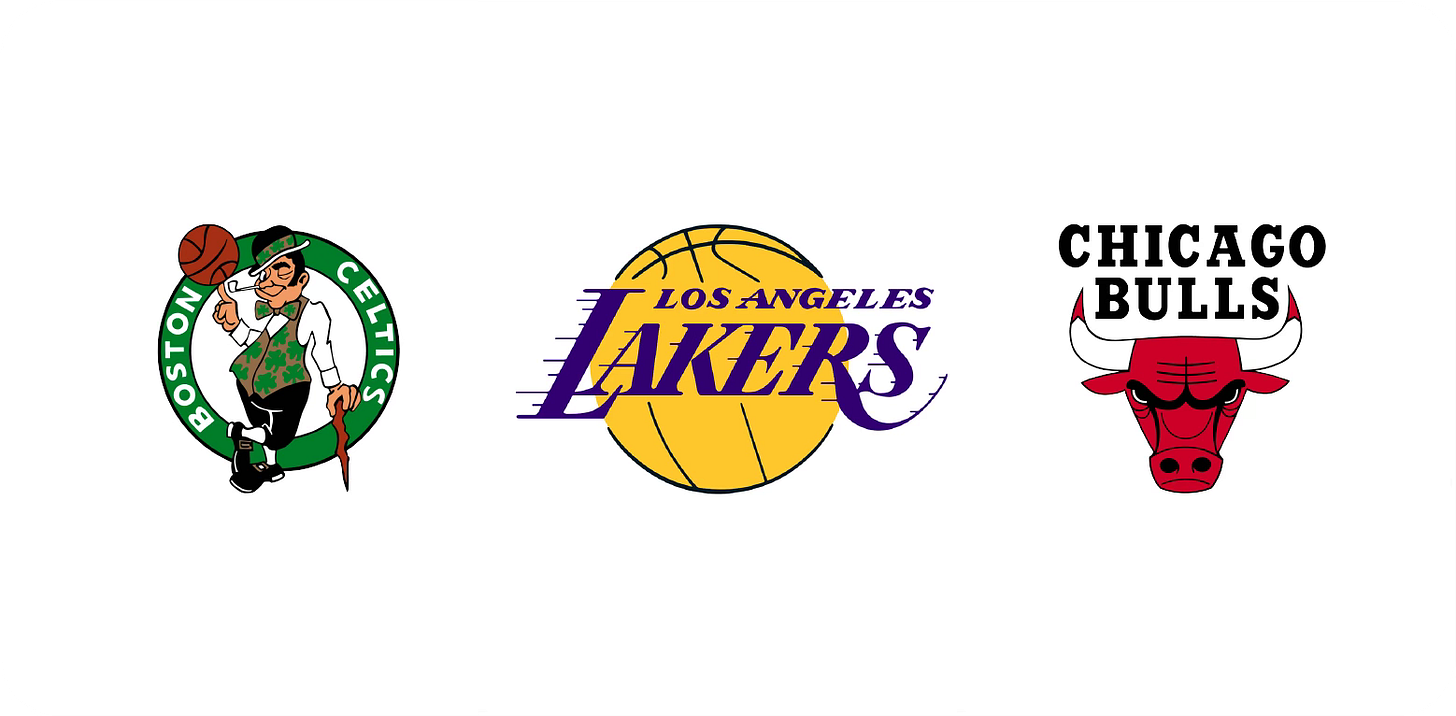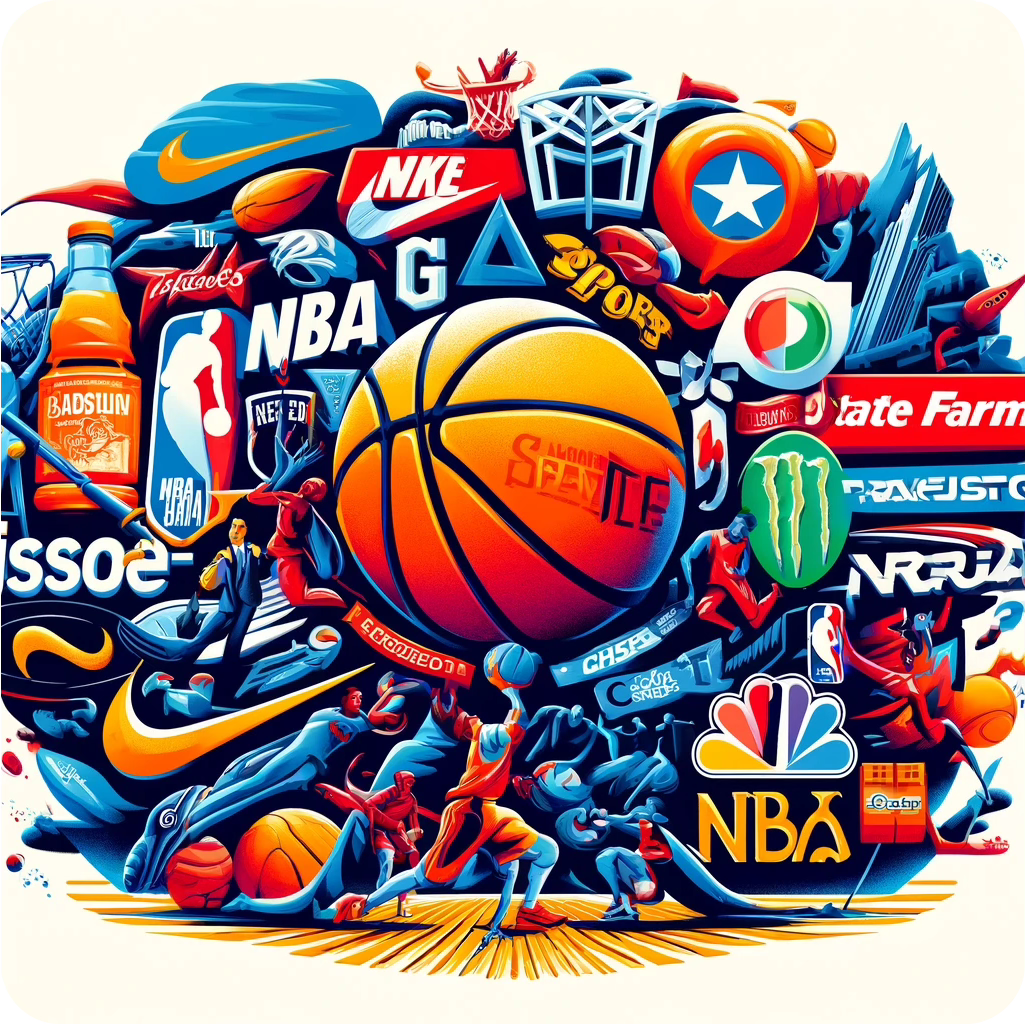Ranking the Most Iconic Logos of NBA Teams: A Visual Slam Dunk
Who holds the title for the most iconic logo in the NBA? In this article, we rank the logos of NBA teams, dissecting the history, creativity, and fan loyalty behind each emblem. Step into the world of sports design and culture as we examine what makes these logos memorable and which ones truly capture the essence of their teams.
Key Takeaways
NBA logos have significantly evolved over the decades, tracing the progression from early representations of team heritage to incorporating sleek, modern designs that maintain historical elements.
The most iconic team logos like the Chicago Bulls, Los Angeles Lakers, and Boston Celtics have become global phenomena, with each design encapsulating deep local or cultural significance, enduring legacies, and a strong brand identity.
Beyond the court, NBA logos have had a substantial impact on pop culture, fashion, and media, further evident in the integration of sponsors like Nike, and are symbols of style and community pride as much as they are of the sports teams.
The Evolution of NBA Logos: A Visual Journey
NBA logos weave a fascinating story of history, artistry, and innovation. NBA logos have evolved from hand-drawn badges of honor in the 1960s to today’s sleek, minimalist symbols, reflecting the game’s evolution over time. As the essence of basketball remains constant, logos have adapted to mirror graphic design advancements and shifts in visual branding.
Yet, amidst this sea of change, some have stood the test of time, like the Chicago Bulls’ emblem, which has remained a constant, unchanged beacon throughout the franchise’s storied history.
The Birth of NBA Team Emblems
In their early days, NBA team emblems served as storytellers, reflecting the unique identities and rich histories of the teams. The Detroit Pistons’ first logo, a cartoonish robot, paid homage to the city’s automotive roots, while the Philadelphia Nationals’ emblem proudly displayed a stylized map of the United States, signaling the national reach of the sport.
With the league’s expansion, the diversity of logos increased, each new emblem enriching the league’s visual anthology. The Golden State Warriors’ symbol, for instance, evolved from the depiction of an Indian to honor its original name, the Philadelphia Phyllis, maintaining a thread of continuity despite the changes. This foundational era of NBA logos laid the groundwork for the long-lasting visual identities that fans recognize and celebrate today.
Modern Transformations
As they transitioned into the modern era, NBA logos transformed, incorporating new elements while retaining old ones. Teams like:
Memphis Grizzlies
Washington Wizards
Oklahoma City Thunder
Toronto Raptors
Charlotte Hornets
Cleveland Cavaliers
New Orleans Pelicans
Reimagined their new logo, infusing them with a fresh vibrancy that echoed their evolving identities. The Toronto Raptors’ aggressive redesign five years prior set a new standard for modernity in sports logos.
The Phoenix Suns’ emblem, maintaining its signature colors over 45 years, was refreshed with a contemporary twist, showcasing the delicate balance between tradition and innovation. Even the NBA’s main logo hasn’t escaped these changes, with fervent fan debates leading to discussions about modernizing the emblem to honor legends like Kobe Bryant and more accurately represent the spirit of the times.
Legacy and Consistency
While new elements are undoubtedly appealing, the power of consistency holds its own unique charm. The Lakers logo, with minimal tweaks since 1961, is a testament to the power of a strong and enduring visual identity. The Chicago Bulls’ emblem has become an international symbol, its unchanged style and color scheme transcending borders and languages. Similarly, the Boston Celtics have held fast to the core elements of their logo, allowing them to maintain a legacy that resonates deeply with their fan base. The NBA silhouette logo itself has become an emblem of the league’s commitment to a consistent and recognizable brand, showcasing the significance of a logo that stands the test of time.
This enduring presence serves to establish a robust brand identity and maintain the brand value within the sport’s culture.
Decoding the Symbolism in NBA Logos
Uncovering the layers of NBA logos reveals a wealth of hidden meanings and symbolism, with every curve, color, and character narrating a story. The Milwaukee Bucks logo, for instance, cleverly incorporates a hidden ‘M’ around the neck of the buck, a nod to the team’s home city. The Houston Rockets’ emblem, with its rocket taking off inside the ‘R’ hoop, forms a subtle ‘H’, symbolizing not just the team’s name but also its hometown.
Even the dynamic logo of the Portland Trail Blazers, featuring competing red and white stripes, represents the on-court clash between two teams of five players. These intricate designs and clever motifs exemplify how NBA logos go beyond mere branding, embedding deeper meanings that connect with fans on a more personal level.
Mascots and Motifs
Mascots and motifs in NBA logos act as visual representations, encapsulating the spirit and characteristics of the teams they symbolize. Some examples include:
The Milwaukee Bucks’ emblem, which transitioned from a gentle deer to a fierce competitor
The Atlanta Hawks’ hawk
The Dallas Mavericks’ cowboy hat
The Brooklyn Nets logo, reminiscent of old New York subway signs
The Utah Jazz logo that ties ‘jazz’ to Utah’s mountains
These symbols have become synonymous with the teams’ names and identities, forging a connection with the local culture and fanbase.
Incorporating such motifs into the logos helps create a unique identity and strengthen the bond with fans, making each emblem an integral part of the team’s story.
Colors and Culture
Colors in sports logos aren’t selected arbitrarily; they are used strategically to elicit emotions and encapsulate a team’s essence. The San Antonio Spurs’ black-and-gray colors, coupled with the iconic spur symbol, pay tribute to the city’s Wild West history, while the New York Knicks’ blue, white, and orange palette connects the team to the city’s flag and its Dutch heritage.
The Indiana Pacers’ branding, with its white, yellow, and blue scheme, emphasizes stability and sporting excellence, a reflection of the team’s core values and the pride of their home state. These thoughtful color choices not only give teams their visual flair but also serve as a rallying cry, uniting fans and players under a common banner of team spirit.
Geographical Significance
The geographical relevance of NBA logos demonstrates their capacity to connect with the communities they represent. Some examples include:
The Golden State Warriors’ emblem, featuring the iconic Bay Bridge, symbolizes the connection between San Francisco and Oakland.
The San Antonio Spurs’ spur is a direct reference to the city’s cowboy culture.
The Los Angeles Lakers’ logo evolved to reflect their new home, while retaining elements of their past when they relocated from Minneapolis.
These logos not only represent the teams, but also the cities and cultures they are associated with.
Denver Nuggets’ logo, with its mountainous terrain and mining background, and the Philadelphia 76ers’ 13 stars, commemorating the original colonies, are powerful examples of how logos can serve as geographical and historical markers, grounding teams in the fabric of their locales.
Spotlight on Iconic NBA Logos
Among the array of NBA logos, some have achieved iconic status, with their designs striking a chord with fans across different generations and borders. These logos have carved out a unique space in the cultural landscape, becoming symbols of their teams and the cities they hail from.
The Los Angeles Lakers’ emblem, known for its striking purple and gold colors, is as identifiable as the Hollywood sign, while the Chicago Bulls’ logo, synonymous with basketball royalty, has gained worldwide recognition.
Los Angeles Lakers: Hollywood Glamour
The Los Angeles Lakers logo embodies the glamour and success synonymous with its city. With its inception coinciding with the team’s move from Minneapolis, the logo’s features include:
Striking yellow and Forum blue colors, a nod to the bright lights and star-studded nights of Los Angeles
Dynamic ‘motion lines’
Custom ‘Bodoni’ typeface, which have defined the Lakers logo since the 1960s
These elements capture the essence of the team’s storied history and its Hollywood home.
It’s a logo that speaks to the heart of Los Angeles, marrying the city’s entertainment legacy with the timeless appeal of one of basketball’s most storied franchises.
Chicago Bulls: A Global Phenomenon
The Chicago Bulls logo, with its fierce red bull and steadfast gaze, extends far beyond the confines of the basketball court. Its widespread recognition is in part due to the Bulls’ dominance in the 1990s, a decade that saw the team rise to international fame. But perhaps more significantly, the logo is intertwined with the legacy of Michael Jordan, whose legendary status carried the emblem to all corners of the globe.
It’s a logo that transcends sport, becoming a symbol of excellence and an emblematic representation of basketball royalty.
Boston Celtics: A Nod to Heritage
The Boston Celtics logo is a heartfelt tribute to the city’s rich Irish heritage. Its colors and imagery, featuring a leprechaun and shamrocks, reflect the cultural roots that run deep in Boston’s history. The white shamrock against the green backdrop is not just a symbol of Irish pride but also a nod to the city’s embrace of its Celtic legacy, which has become an integral part of Boston’s identity since the 1950s.
This emblem is more than a team logo; it’s a celebration of community, heritage, and the enduring spirit of one of the NBA’s most storied franchises.
Behind the Design: NBA Logo Creators
The creativity behind NBA logos often comes from unsung heroes – talented designers whose vision has sculpted the identity of the league and its teams. From the inception of the iconic NBA silhouette logo to the countless team emblems that have graced the courts, these designers have left an indelible mark on the sport.
Alan Siegel, who designed the NBA logo, was inspired by a dynamic pose of Lakers player Jerry West. He created a symbol that would serve as a beacon of basketball excellence. It’s a peek behind the curtain into the creative process that brings these logos to life.
The Artists' Vision
The vision of the artists behind NBA logos often stems from a deep understanding of the sport and its culture. Alan Siegel’s background as an accomplished high school basketball player informed his approach to designing the NBA logo, blending his passion for the game with his expertise in brand identity.
The Lakers logo, for instance, is renowned for its dynamic ‘motion lines’, a feature that has defined its appearance and captured the essence of the team’s energy and spirit since the 1960s. These artists’ ability to encapsulate the soul of a team in a single emblem is a testament to their vision and the profound impact of their work on the sport’s visual narrative.
Collaboration and Rebranding
Rebranding an NBA logo is a collaborative effort involving team leadership, marketers, and graphic designers. They work together to create an emblem that:
Connects with fans
Reflects the team’s evolving identity
Aligns with the strategic vision and objectives of the team
Captures the hearts of a new generation while honoring the past
This process is about more than aesthetics; it’s about creating a logo that represents the team in the best possible way.
Successful rebranding efforts, such as the Toronto Raptors’ modernized logo, showcase the positive outcomes of these partnerships, blending tradition with a contemporary twist to reinvigorate the team’s brand.
Fan Engagement in Logo Design
In the world of NBA logo design, fans have a critical role. Their opinions, shared across blogs and forums, play a vital part in guiding the redesign process. It’s a democratic approach to branding, where fan sentiment and historical logo rankings are meticulously considered to ensure that the new emblems resonate with the audience.
This inclusive strategy not only strengthens the bond between the fans and the teams but also ensures the logos maintain their cherished status in the hearts of those who matter most—the fans.
The Impact of Sponsorship on NBA Logos
The inclusion of jersey patch sponsorships since 2017 has brought significant changes to the landscape of NBA logos. These patches, now a common feature on team kits, have opened new revenue streams and evolved the aesthetics of team branding.
With an annual yield surpassing $250 million, the financial implications of these sponsorships are as substantial as their visual impact on the game.
Brand Partnerships
Choosing brand partners for NBA teams is a strategic process aimed at aligning with the team’s values and mission. These partnerships aim to enhance the fan experience and create a synergy between the team’s identity and the local community. A partnership that resonates with fans, such as the Utah Jazz’s collaboration with LiveView Technologies, exemplifies the thoughtful integration of brand partners into team logos.
This alignment not only preserves the team’s identity but also provides an additional dimension to their brand story.
Sponsorship Trends
The landscape of NBA sponsorships is in constant flux, with teams forming alliances with tech and entertainment entities to enrich live content and the fan experience. The Indiana Pacers’ jerseys featuring QR Codes and the Phoenix Suns’ partnership with PayPal are indicative of the trend towards incorporating technology into team branding. These partnerships are not only diversifying in sector but also in scope, with companies focusing on more substantial deals that promise deeper engagement and visibility.
As the world of sponsorships burgeons, teams are leveraging these alliances to create a more immersive and connected fan experience.
From Court to Culture: NBA Logos in Pop Culture
NBA logos have broken the barriers of sports, becoming an integral part of popular culture. Their influence can be seen in fashion, media, and an array of products, showcasing their role as cultural icons beyond the court. The prominence of NBA logos in films and TV shows, recognized even by non-sports enthusiasts, speaks to their widespread appeal and the enduring nature of their design.
As a fashion statement, these logos have found their way into streetwear and high-end fashion alike, illustrating the league’s far-reaching cultural impact.
Fashion Statements
The inclusion of NBA logos in the fashion world has sparked a style revolution. Streetwear brands like Supreme have embraced NBA logos, weaving them into collections that resonate with the rhythm of modern fashion. These emblems have also graced luxury fashion items, merging the energy of basketball with the exclusivity of high-end design. The integration of corporate sponsor logos, such as Nike’s swoosh and Jordan Brand’s ‘Jumpman’, onto team jerseys, has further cemented the NBA’s influence on fashion trends. It’s a testament to the cultural power and versatility of NBA logos, which have become staples in the wardrobes of fashion-forward individuals around the world.
Media and Entertainment
The representation of NBA logos in films and TV shows has crucially contributed to their status as cultural markers. By embedding these logos into storylines, media content creators have leveraged the brand’s recognition to connect with audiences and enrich their narratives. The result is a symbiotic relationship where the logos enhance the media’s authenticity, and the media, in turn, amplifies the logos’ cultural resonance.
This dynamic interplay has transformed NBA logos into symbols with significance that extends far beyond the basketball arena and into the broader cultural conversation.
Merchandising Power
The commercial power of NBA logos can’t be denied, as their presence on merchandise crucially engages fans and generates significant revenue for the league. The growth of jersey sponsorships has added a new dimension to team finances, while the design of the jerseys themselves, featuring team logos, remains crucial in attracting viewers and boosting sales.
The merchandising power of these logos is a reflection of their appeal, as fans adorn themselves with the emblems of their favorite teams, proudly displaying their loyalty and support.
Comparing NBA and Other Sports Logos
NBA logos distinguish themselves in the sports world through their unique design language and ability to encapsulate the essence of the teams and the league. When compared to other sports, such as the NFL, the contrast in styles becomes apparent, with NBA emblems often showcasing a more modern, vibrant aesthetic.
Each logo tells its own story, not just of the team it represents, but also of the league’s history, marked by expansion and mergers, such as the significant addition of four teams from the American Basketball Association in 1976.
NBA vs. NFL: A Contrast in Styles
The stylistic differences between NBA and NFL logos reflect the varying marketing strategies and values upheld by each league. NBA logos, with their dynamic designs and vibrant colors, lean towards modernity, while NFL logos tend to embrace a more traditional, emblematic style. This difference is not just aesthetic but also philosophical, with the NBA focusing on marketing individual stars, and the NFL centering on the sport and teams as a whole.
The resulting contrast in logo design philosophies is a mirror of the leagues’ distinct modes of fan engagement and the personal fame and financial success of their athletes.
International Basketball Logos
Internationally, basketball team logos possess a unique flair that sets them apart from their National Basketball Association (NBA) counterparts. With designs that often incorporate local cultural elements and historical references, these logos provide a glimpse into the diverse artistic tastes and traditions of their home countries.
The distinctiveness of international basketball logos lies in their ability to capture a sense of place and pride, reflecting the variety of design approaches that flourish outside the NBA’s sphere.
Cross-Sport Logo Trends
Despite variations across leagues and sports, there are shared elements that unite the design of sports logos. Simplicity for memorability, symbolism to encapsulate the essence of the sport, and adaptability for various media are elements shared by logos irrespective of the game they represent. The trend towards bold colors, simple layouts, and strong, Sans-Serif typefaces is evident across sports, ensuring logos are impactful and easily recognizable.
These designs are crafted to stand the test of time, avoiding passing fads to build a lasting connection with audiences and solidify the teams’ presence in a competitive market.
Summary
In the realm of professional sports, NBA logos stand as powerful symbols, embodying the history, culture, and spirit of the teams they represent. From the vintage charm of their origins to the sleek appeal of modern designs, these emblems have evolved to become cultural icons, transcending the world of basketball to leave their mark on fashion, media, and popular culture. As the final buzzer sounds on our exploration, it’s clear that the legacy of NBA logos is as enduring as the game itself, a visual slam dunk that continues to captivate fans and shape the identity of the league.
Frequently Asked Questions
Why have some NBA logos remained unchanged for decades?
Some NBA logos have stayed the same for decades because they have a strong brand identity and are associated with the team's history and success, making them timeless and resonating with fans across generations.
How do NBA logos incorporate local culture?
NBA logos incorporate local culture by integrating elements of the community's identity and geography, such as the Bay Bridge in the Golden State Warriors' logo or the cowboy spur in the San Antonio Spurs' logo. So, they help to strengthen the connection with their communities.
What role does fan feedback play in the NBA logo redesign process?
Fan feedback plays a crucial role in the NBA logo redesign process, as teams gather input from various sources, including social media, to ensure that any changes resonate with the fans and reflect their preferences.
How do NBA logos influence fashion?
NBA logos have a big impact on fashion, as they're often used in streetwear and high-end fashion. Many fashion brands collaborate with NBA teams to create collections that merge basketball energy with current style trends.
What is the financial impact of jersey patch sponsorships in the NBA?
Jersey patch sponsorships in the NBA have a significant financial impact, generating over $250 million in annual revenue. They play a crucial role in team financing and brand partnerships.


